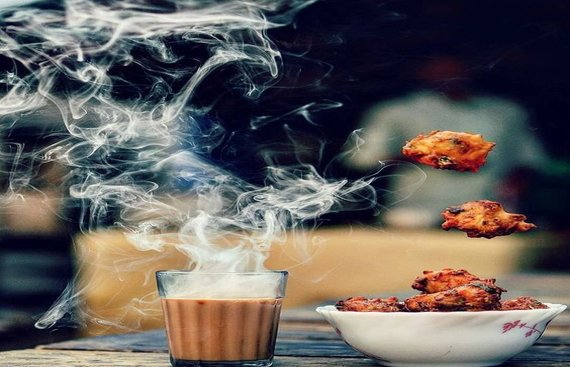Indian Monsoon Delicacies: From Chai & Pakoras to roasted Bhutta (Corn)

As monsoon begins, a breath of fresh air along with steaming mugs of ginger-infused Chai and piping hot Pakoras might be the very first living image to visualize. Additionally, a sign of comfort witnesses the emerald leaves and inhales petrichor after a scorching heatwave. The season also comes bundled with enormous food cravings. Moreover, Indian culinary traditions in the monsoon are far more prosperous and more diverse. The monsoon months bring an exciting variety of flavors with unique seasonal produce and culinary rituals, regional specialties, and luxurious festive treats.
According to the seasons, every corner of the country follows a significant food habit. Ayurveda, the ancient science of food and medicine, has also recommended this. The seasonal changes are considered as a change in the natural elements. Consequently, it has directed its influences on the three elements or doshas - Vata (air/wind), Pitta (fire), and Kapha (earth and water) – that constitute the human body. The science behind seasonal diets says they are designed to balance the body and soothe the elements provoked during a particular season.
So, here is the perfect solution for a dark, gloomy day – hot, steamy food delicacies! It’s a call to experience more than the cold rain droplets on the window and filming yourself in some sad music video. It’s time to accompany your heart with some lip-smacking monsoon platter.
Stimulating Immunity
![]()
The dark, damp monsoon months are also inclined to diseases, and the consumption of warm, spicy, tangy, and oily food (known to balance the Vata dosha) are recommended. The spices that aid digestion and medicinal blends like the Trikatu (a mix of dry ginger, black pepper, and long pepper), or even a combination of amla and rock salt, are encouraged.
Having hot soups with an accurate proportion of spices can protect you from the cold. The satisfaction of hot soup flowing down your throat when it is raining outside is unbeatable. Veggies or simple tomato soup can also make for a healthy, tasty, and nutritious option.
In Kerala, the traditional monsoon menu embraces medicinal porridges and gruels like the Karakadaka Kanji – a rice gruel cooked in coconut milk, filled with medicinal herbs and spices such as fenugreek, coriander and cumin seeds, dry ginger, cardamom, cloves, caraway, and other rarer ingredients. Only the GI-tagged Njavara rice, known for its remedial qualities, is used for this recipe.
Seasonal clips and regional curlicues
![]()
Vegetables like gourds, cucumbers, and squashes are the most readily available in various parts of the country. A particular seasonal vegetable is the spiky teasel gourd, used to cook tasty stir-fries, curries, and crisp fritters. Bengal is famous as Kakrol, stuffed with freshly grated coconut spiked with pungent mustard or spicy minced prawns, dipped in batter, and fried.
As food preservation is against the nature of the monsoon, the long-lasting edible roots and tubers like Yam or Suran and raw bananas are fit for the monsoon pantry. A dish called Raw banana kachori with yogurt dip will make your taste buds sing.
An exciting monsoon dish popular from the Mangalorean kitchen is the Theryacheyo Ganti – colocasia leaves are tied into knots, individually, and left to fade for a whole day before being cooked into a tangy curry. Another Mangalorean traditional curry cooked with Taikulo, hog plums, and jackfruit seeds. Jack fruit seeds, possibly stored from the summer’s yield of jack fruits as a safeguard for the rainy days, are a prized ingredient for several monsoon pantries.
Furthermore, wild seasonal mushrooms, like the Gud Gud Alambe from the Konkan coast, the nutty Alami mushrooms that cultivate natural in the Goan hinterland every monsoon, or the wild mushrooms of the Khasi Hills in the North East – these are desirable monsoon banquets.
Comfort food
![]()
Above all, the first drop of the rain compels one to crave typical felicitous food. Interestingly, every region has its rainy-day favorites - Malpua and Meetha Pura up North, spicy Mirchi Badas in Rajasthan, Khichuri in Bengal, Vada Pao from Mumbai Street Food, momos, and chai-pakoras elsewhere.
A rainy day becomes more magical with a cup of piping hot masala chai. We Indians take our Tea very seriously. Its strong aroma and spicy cardamon flavor or ginger add to the authenticity of the season. A plate of sizzling hot Pakoras is fried pockets of heaven along with the chutneys. It always comes as a complement with the Chai.
How does anyone miss Bhutta (Corn)? Monsoon would be incomplete without savoring the traditional charcoal roasted-Bhutta. Relishing the burnt flavor of the roasted corn with some tangy masala made from black pepper, salt, red chili powder, and lemon juice—is the combo that cannot go wrong! Exclusively while getting caught in the rain!
Momos, a South Asian dumpling, is a favorite for all! Since veg and non-veg are its available options, it is a delight to every foodie’s life. Devouring a plate of hot steamed (or fried) Momos is the thing you need to wash those blues away!
Another hot, crispy, and crunchy food item that is a necessity during the rainy season! Mouth-watering deep-fried samosas and their fragrance isn’t something that anyone can miss during the monsoon season. Complemented with tamarind chutney or mint chutney is just what a food lover must be looking forward to.
Moreover, these are to name a few. The Indian delicacies have a lot more on the monsoon platter to relish when it’s raining outside. As Khushwant Singh, an Indian author, has said in his book I Shall Not Hear the Nightingale “What the four seasons of the year mean to the European, the one season of the monsoon means to the Indian. It is preceded by desolation; it brings with it hopes of spring; it has the fullness of summer and the fulfillment of autumn all in one,” glorifies the beauty of the season.

